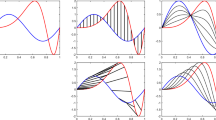Abstract
This paper proposes a spherical coordinate-based kernel principal component analysis (PCA). Here, the kernel function is the nonlinear transform from the Cartesian coordinate system to the spherical coordinate system. In particular, first, the vectors represented in the Cartesian coordinate system are expressed as those represented in the spherical coordinate system. Then, certain rotational angles or the radii of the vector are set to their corresponding mean values. Finally, the processed vectors represented in the spherical coordinate system are expressed back in the Cartesian coordinate system. As the degrees of the freedoms of the processed vectors represented in the spherical coordinate system are reduced, the dimension of the manifold of the processed vectors represented in the Cartesian coordinate system is also reduced. Moreover, since the conversion between the vectors represented in the Cartesian coordinate system and those represented in the spherical coordinate system only involves some elements in the vectors, the required computational power for the conversion is low. Computer numerical simulation results show that the mean squares reconstruction error via the spherical coordinate-based kernel PCA is lower than that via the conventional PCA. Also, the required computational power is significantly reduced.








Similar content being viewed by others
References
Yildiz, K.: Dimensionality reduction-based feature extraction and classification on fleece fabric images. Signal Image Video Process. 11, 317–323 (2017)
Routray, S., Ray, A.K., Mishra, C.: An efficient image denoising method based on principal component analysis with learned patch groups. Signal Image Video Process. 1, 1–8 (2019)
Thomaz, C.E., Giraldi, G.A.: PCA-based magnification method for revealing small signals in video. Signal Image Video Process. 12, 1293–1299 (2018)
Sharma, A., Paliwal, K.K.: Fast principal component analysis using fixed-point algorithm. Pattern Recognit. Lett. 28, 1151–1155 (2007)
Karamizadeh, S., Abdullah, S.M., Manaf, A.A., Zamani, M.: An overview of principal component analysis. J. Signal Inf. Process. 4, 173–175 (2013)
Dong, S., Hu, R.M., Tu, W.P., Zheng, X., Jiang, J.J., Wang, S.: Enhanced principal component using polar coordinated PCA for stereo audio coding. In: IEEE International Conference on Multimedia and Expo, pp. 628–633 (2012)
Dong, S., Hu, R.M., Tu, W.P., Cheng, X.C., Zheng, X.: High efficiency stereo audio compression method using polar coordinate principle component analysis for wireless communications. Inf. Theory Coding 10, 98–111 (2013)
Campos, L.M.B.C., Cunha, F.S.R.P.: On hypersherical Legendre polynomials and higher dimensional multipole expansions. J. Inequal. Spec. Funct. 1–28 (2012)
Martinez, D.R., Bond, R.A., Vai, M.M.: High Performance Embedded Computing Handbook: A Systems Perspective, pp. 5–7. CRC Press Taylor and Francis Group, Boca Raton (2008)
Tao, Q., Wu, G., Wang, J.: Learning linear PCA with convex semi-definite programming. Pattern Recognit. 40(10), 2633–2640 (2007)
Balcerowska, G., Siuda, R.: Inelastic background subtraction from a set of angle-dependent XPS spectra using PCA and polynomial approximation. Vacuum 54(1–4), 195–199 (1999)
Xiao, Y., Wang, H., Xu, W.: Model selection of Gaussian kernel PCA for novelty detection. Chemom. Intell. Lab. Syst. 136, 164–172 (2014)
Lu, M., Huang, J.Z., Qian, X.: Sparse exponential family principal component analysis. Pattern Recognit. 60, 681–691 (2016)
Yang, W., Sun, C., Zhang, L., Ricanek, K.: Laplacian bidirectional PCA for face recognition. Neurocomputing 74(1–3), 487–493 (2010)
Funding
This paper was supported partly by the National Nature Science Foundation of China (No. U1701266, No. 61372173 and No. 61671163), the Team Project of the Education Ministry of the Guangdong Province (No. 2017KCXTD011), the Guangdong Higher Education Engineering Technology Research Center for Big Data on Manufacturing Knowledge Patent (No. 501130144), the Guangdong Province Intellectual Property Key Laboratory Project (No. 2018B030322016) and Hong Kong Innovation and Technology Commission, Enterprise Support Scheme (No. S/E/070/17).
Author information
Authors and Affiliations
Corresponding author
Additional information
Publisher's Note
Springer Nature remains neutral with regard to jurisdictional claims in published maps and institutional affiliations.
Rights and permissions
About this article
Cite this article
Guo, Y., Ling, B.WK. Spherical coordinate-based kernel principal component analysis. SIViP 15, 511–518 (2021). https://doi.org/10.1007/s11760-020-01771-8
Received:
Revised:
Accepted:
Published:
Issue Date:
DOI: https://doi.org/10.1007/s11760-020-01771-8




